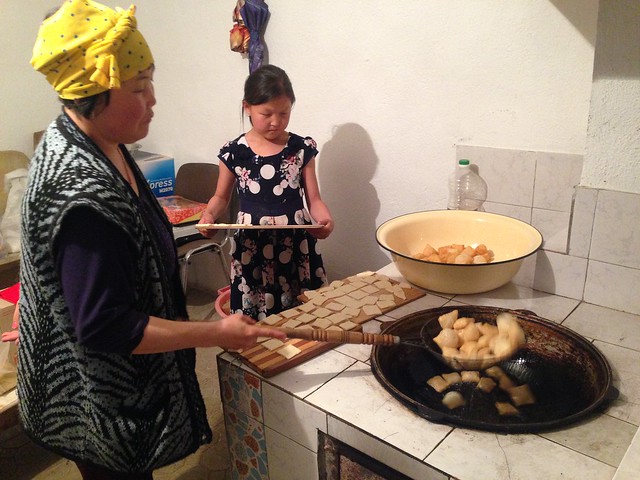I’ve been fortunate to live with several host families with considerable culinary talent, and even more fortunate that my host moms are patient enough to teach me to make traditional Kyrgyz foods. Last week, my host aunt Venera was throwing a party for the other teachers at school; to prepare for the party, she came over to use our kitchen to make a bunch of salads and the ubiquitous borsook, fried bits of dough that get sprinkled over dinner tables at Kyrgyz parties. Here’s the play-by-play for making borsook:
Step 1: Prep the dough — камыр жасоо
Gather up the ingredients (6 cups grams flour, 4 cups of warm water, 100 grams of sunflower oil, 20 grams of yeast, 2 teaspoon of salt, 2 teaspoon of sugar) and mix them in a chara (the big yellow bowl in the picture below). Cover the chara with a few layers of tablecloths, but it you only have one, piling on some blankets or sweaters should do the trick. Let the dough rise for a few hours, then cut out chunks that are more manageable than the mountain you’ve made. “Soften” each chunk by rolling it in flour and kneading it for a few seconds.
Step 2: Roll out the dough (but not too much at once) — камыр жайюу
Every Kyrgyz household has a huge rolling stick; now’s its time to shine. After “softening” and flattening each chunk of dough, it gets rolled out nice and thin with the stick. After it’s been rolled, it gets set under a tablecloth. You shouldn’t roll out too many dough chunks at a time, because you can’t cut and fry them fast enough — the dough will harden, and your final product will suffer.
Step 3: Cut the dough – камыр кезуу
Borsook, in the Kyrgyz tradition, is cut up into square-shaped bits before it’s fried. (Compare to Kazakh baursak, which is rolled up into little balls.) My host aunt Venera was a speed demon with the cutting and slicing; her daughter Sako took her time and used the special “borsook cutter” tool to give the edges a cool design.

Much dough, such borsook
Step 4: Fry the dough — камыр кууруу
My host mom Cholpon fired up the kazan, the big cauldron thing featured in the picture below, to start frying the borsook. She explained that it’s best to use cotton oil to fry borsook because it doesn’t mess up the metal on the kazan. I had never heard of cotton oil before, but the kazan looks good, so I trust Cholpon Eje’s call. Cholpon Eje wasn’t a fan of the borsook bits with the decorative edges, chunks of dough fell off during the frying process and made the oil turn black. After several hours of frying (which involved the younger girls running back and forth between the main house and the outside kitchen carrying trays of borsook), everyone was kind of tired with the process – including the oil, which my host sister Aika described as “Coca Cola-colored.” The last few chunks of dough were cut in bigger slices; the size matters, because the end product has a different name: kuiymak.


Step 5: Admire the dough — камыр суктануу
And finally, the finished product. Light, fluffy, oily borsook. Aika had the job of spreading the borsook out to cool/dry/whatever on our guesting room table. Venera Eje took about half of the batch to her work party the next day, but the rest of it stayed in our kitchen and quickly ended up in our bellies. It’s laid out on guesting tables and can go sweet or savory; my favorite way to eat borsook is as a vessel for homemade strawberry jam.


(Optional) Step 6: Experimentation in the name of Goal 2
One of Peace Corps‘ three goals is “to help promote a better understanding of Americans on the part of the peoples served.” While I watched Cholpon Eje work her magic at the kazan, we chatted about American foods and recipes. I brought up donuts, but she didn’t seem too keen on the idea of a pudding-filled borsook. She got excited about cheese curds, though, so she sent Aika to cube up some cheese from the fridge. We tossed it in the kazan to see what came out… This was the result:

We ended up rolling the cheese into a kuiymak and calling it “borsook po-amerikanskii.” It tasted a lot better than it looked, and it warmed my heart to see my host family excited by the idea of deep-fried cheese curds. Midwestern cultural hegemony for the win!




wonderful post
Yum! That looks so good!
That was an enjoyable read and experience. Thank you.